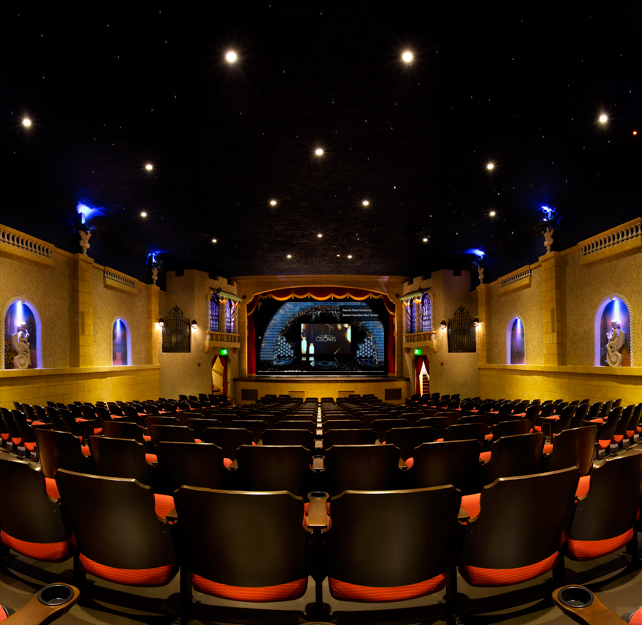How many times each summer–and once again around the holidays–do you pay $8, $10, or even $15 or more to be herded into a multiplex theater to see a blockbuster unfold on a giant screen? If you’re a movie buff like most of us in the AV industry are, and especially if you don’t have a custom home theater setup at home, we bet you went to the movies at least a few times this summer.
No matter how often we go to the movies, the high-tech experience never ceases to “wow” us. Surround sound, the massive curved screen, high-definition visuals all bring our cinema heroes closer to us (sometimes even in 3D). Having said that, the experience tends to be somewhat homogenous. If you’ve been to one multiplex, you’ve seen them all. And they typically lack the charming ambiance we find in theaters from earlier centuries.
Fortunately, a number of early 1900s theaters still exist, nestled on the Main Streets of small towns, offering $1 matinees and $5 prime time tickets for the whole family. (Main Street: There’s another notion we can wax nostalgic about…)
Technology Challenges in Historic Theaters
Historic theaters face unique challenges when it comes to their technology systems. Single screen theaters often have lower revenues and limited alternate funding, making it difficult and sometimes impossible to secure movies “on the break” — the same day as they are released. Worse, old-school, 8mm projection systems and digital, high-definition content don’t work well together, and sadly, don’t provide the quality today’s audiences expect. It’s sad, really, when you think about it. But that’s yet another blog, for another day.
Every so often, though, a town’s historic society or private investors (or both) step in and recognize the importance of preserving these buildings and maintaining the old-world charm of the original moving picture experience, while introducing the high-quality, high-definition imagery and high-fidelity sound today’s theatergoers demand. One such example is the Tivoli Theatre in Spencer, Indiana, and KMB client Stewart Filmscreen was both thrilled and honored to be part of the restoration project.
Viquesney Tivoli Theatre History
Opened in 1928, the Mission Revival Style Tivoli Theatre building boasted a 1,200-seat motion picture auditorium that quickly became a source of both entertainment and pride to Spencer, Indiana, residents. Of particular note was a midnight blue ceiling with twinkling stars – one of the first installations of its type, and representative of cutting-edge technology of the time.
Preserving History
Tivoli Theatre closed in May 1999, and did not reopen until 2013, when benefactor Cook Group Inc. of Bloomington, Indiana, made a donation to restore the Tivoli Theatre to its former glory, updating its audiovisual and lighting systems to meet the discerning expectations of today’s movie enthusiasts, while maintaining the building’s historical charm.
Old Building, New Tech
Audio visual systems integrator Eric Stiening, president of Bloomington, Ind.-based Experience Technology LLC was brought in to consult early in the Tivoli Theatre restoration, working as part of the planning team to design and specify the systems that would be needed. This was critical to the project’s success.
“Everyone, including the electrical contractor, lighting contractor, rigging company, project manager, architect and others worked together to bring together a flawless system,” Stiening said in a case study published on the Stewart Filmscreen website. “We wanted the auditorium to be as close to the original as possible, but the fun part was delivering a new digital cinema system and integrating high-powered speakers into a structure that harkens back to when it opened in 1928.”
Experience Technology called on Stewart Filmscreen engineers to design a 30-foot, custom four-way Electrimask Screenwall to seamlessly handle images in Ultra HD and higher, as well as classic content shot in 4:3 and other aspect ratios. The screen sits as a centerpiece in the 316-seat auditorium, which also includes high-powered JBL speakers, and a star-studded ceiling with an LED constellation designed to match the exact star alignment as it would have appeared on the night of the theatre’s original opening on December 31, 1928. You can see more about how the project came together in this video interview with Stiening and this article by Jeremy Glowacki, editor of Residential Systems magazine.
Achieving Relevance Through Technology
Upgrades in historic buildings, such as those completed by Experience Technology in Tivoli Theatre, require special considerations; contractors, including audiovisual integrators, cannot change the building’s infrastructure or certain historic architectural elements. Classic theatres (or theaters, for that matter) must be retrofitted for HD and greater display technology, while maintaining the capabilities to play older formats, or even host live productions. Funding is beyond challenging, but there are creative ways to secure funding that can be fruitful, like through Kickstarter or indiegogo campaigns and local, grassroots level efforts. (Again, more on that in another blog, on another day.)
When such a project is successful, it stands as testament to the audiovisual integration firms’ skill, and also represents the commercial integrators’ important role in preserving a piece of history. That’s part of what makes projects like the Tivoli Theatre restoration so special. It goes beyond screens and speakers, wires and boxes, to the heart of what technology can do: Make the old and forgotten relevant once again.
Have you ever seen a movie in a classic, small town theater (or theatre) or played a role in revitalizing such a space? What was the experience like for you? Please share and in so doing, help us bring light to some of these amazing, historic theaters.

